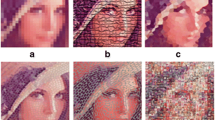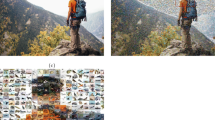Abstract
Photomosaic images are composite images composed of many small images called tiles. In its overall visual effect, a photomosaic image is similar to the target image, and photomosaics are also called “montage art”. Noisy blocks and the loss of local information are the major obstacles in most methods or programs that create photomosaic images. To solve these problems and generate a photomosaic image in this study, we propose a tile selection method based on error minimization. A photomosaic image can be generated by partitioning the target image in a rectangular pattern, selecting appropriate tile images, and then adding them with a weight coefficient. Based on the principles of montage art, the quality of the generated photomosaic image can be evaluated by both global and local error. Under the proposed framework, via an error function analysis, the results show that selecting a tile image using a global minimum distance minimizes both the global error and the local error simultaneously. Moreover, the weight coefficient of the image superposition can be used to adjust the ratio of the global and local errors. Finally, to verify the proposed method, we built a new photomosaic creation dataset during this study. The experimental results show that the proposed method achieves a low mean absolute error and that the generated photomosaic images have a more artistic effect than do the existing approaches.
Similar content being viewed by others
Explore related subjects
Discover the latest articles and news from researchers in related subjects, suggested using machine learning.References
Yang X, Mei T, Xu Y Q, Rui Y, Li S. Automatic generation of visual-textual presentation layout. ACM Transactions on Multimedia Computing, Communications, and Applications, 2016, 12(2): 1–22
Gatys L A, Ecker A S, Bethge M. Image style transfer using convolutional neural networks. In: Proceedings of IEEE Conference on Computer Vision and Pattern Recognition. 2016, 2414–2423
Gao P, Wu J, Lin Y, Xia Y, Mao T. Fast Chinese calligraphic character recognition with large-scale data. Multimedia Tools and Applications, 2015, 74(17): 1–18
Seo S, Kang D. A photomosaic image generation method using photo annotation in a social network environment. Multimedia Tools and Applications, 2016, 75(20): 12831–12841
Lee H Y. Generation of photo-mosaic images through block matching and color adjustment. International Journal of Computer and Information Engineering, 2014, 8(3): 457–460
Blasi G D, Petralia M. Fast photomosaic. In: Proceedings of International Conference in Central Europe on Computer Graphics, Visualization and Computer Vision. 2005, 1–2
Deligiannis N, Comelis B, Rodrigues M R, Daubechies I. Multi-modal dictionary learning for image separation with application in art investigation. IEEE Transactions on Image Processing, 2016, 26(2): 751–764
Li C L, Su Y, Wang R Z. Extended photomosaic with QR code capability. In: Proceedings of IEEE International Conference on Multimedia and Expo Workshops. 2017, 345–350
Silvers R, Michael H. Photomosaics. New York: Henry Holt and Company, 1997
Narasimhan H, Satheesh S. A randomized iterative improvement algorithm for photomosaic generation. In: Proceedings of World Congress on Nature and Biologically Inspired Computing. 2009, 777–781
He Y, Zhou J, Yuen S Y. Composing photomosaic images using clustering based evolutionary programming. Multimedia Tools and Applications, 2019, 78(18): 25919–25936
Lee H Y, Automatic photomosaic algorithm through adaptive tiling and block matching. Multimedia Tools and Applications, 2017, 76(22): 24281–24297
Fujisawa M, Amano T, Taketomi T, Yamamoto G, Uranishi Y, Miyazaki J. Interactive photomosaic system using GPU. In: Proceedings of ACM International Conference on Multimedia. 2012, 1297–1298
Yang Y, Ito Y, Nakano K. Photomosaic generation by rearranging subimages, with GPU acceleration. In: Proceedings of IEEE International Parallel and Distributed Processing Symposium Workshops. 2017, 942–951
Chavan A S, Manjrekar A A. Data embedding technique using secret fragment visible mosaic image for covered communication. In: Proceedings of International Conference on Information Processing. 2016, 260–265
William P, Lumsden J, Nabney I T. The Mosaic test: measuring the effectiveness of colour-based image retrieval. Multimedia Tools and Applications, 2013, 64(3): 695–716
Chen D, Yuan L, Liao J, Yu N, Hua G. StyleBank: an explicit representation for neural image style transfer. In: Proceedings of IEEE Conference on Computer Vision and Pattern Recognition. 2017, 2770–2779
Chu H K, Chang C S, Lee R R, Mitra N J. Halftone QR codes. ACM Transactions on Graphics, 2013, 32(6): 217
Xu M, Su H, Li Y, Li X, Liao J, Niu J, Lv P, Zhou B. Stylized aesthetic QR code. IEEE Transactions on Multimedia, 2019, 21(8): 1960–1970
Yu Z, Lu L, Yanwen Guo Y, Fan R, Liu M, Wang W. Content-aware photo collage using circle packing. IEEE Transactions on Visualization and Computer Graphics, 2014, 20(2): 182–195
Liu L, Zhang H, Jing G, Guo Y, Chen Z, Wang W. Correlation-preserving photo collage. IEEE Transactions on Visualization and Computer Graphics, 2018, 24(6): 1956–1968
Wang J, Quan L, Sun J, Tang X, Shum H Y. Picture collage. In: Proceedings of IEEE Conference on Computer Vision and Pattern Recognition. 2006, 347–354
Liu T, Wang J, Sun J, Zheng N, Xiaoou Tang X, Shum H Y. Picture collage. IEEE Transactions on Multimedia, 2009, 11(7): 1225–1239
Fang F, Yi M, Feng H, Hu S, Xiao C. Narrative collage of image collections by scene graph recombination. IEEE Transactions on Visualization and Computer Graphics, 2017, 24(9): 2559–2572
Kuhn H W. The hungarian method for the assignment problem. Naval Research Logistics Quarterly, 1955, 2(1): 83–97
Kumar N, Berg A C, Belhumeur P N, Nayaret S K. Attribute and simile classifiers for face verification. In: Proceedings of IEEE International Conference on Computer Vision. 2009, 365–372
Acknowledgements
The authors would like to thank the anonymous reviewers for their valuable and insightful comments on an earlier version of this manuscript. This work was supported by the National Natural Science Foundation of China (Grant Nos. 61871196, 61673186, and 61602190), the Natural Science Foundation of Fujian Province of China (2019J01082 and 2017J01110) and the Promotion Program for Young and Middle-aged Teacher in Science and Technology Research of Huaqiao University (ZQN-YX601 and ZQN-710).
Author information
Authors and Affiliations
Corresponding author
Additional information
Hongbo Zhang received a PhD in Computer Science from Xiamen University, China in 2013. Currently, he is an associate professor with the School of Computer Science and Technology of Huaqiao University, China. He is the member of Fujian key laboratory of big data intelligence and security. His research interests include computer vision and pattern recognition.
Xin Gao is currently working toward an MS degree at the Harbin Institute of Technology Shenzhen Graduate School, China. Her research interests include image processing, multimedia data analysis, computer vision and machine learning.
Jixiang Du received a PhD in Pattern Recognition and Intelligent System from the University of Science and Technology of China (USTC), China in 2005. He is currently a professor at the School of Computer Science and Technology at Huaqiao University, China. He is the director of Fujian key laboratory of big data intelligence and security. His current research interests mainly include pattern recognition and machine learning.
Qing Lei received a PhD from the Cognitive Science Department of Xiamen University, China. She joined the faculty of Huaqiao University, China in 2005. Her research interests include human motion analysis and object detection/recognition.
Lijie Yang received a PhD in software engineering from the University of Macau, China. Currently, she is an associate professor with the school of Computer Science and Technology, Huaqiao University, China. Her research interests include computer graphics and computer animation.
Electronic Supplementary Material
Rights and permissions
About this article
Cite this article
Zhang, H., Gao, X., Du, J. et al. Tile selection method based on error minimization for photomosaic image creation. Front. Comput. Sci. 15, 153702 (2021). https://doi.org/10.1007/s11704-020-9242-6
Received:
Published:
DOI: https://doi.org/10.1007/s11704-020-9242-6




